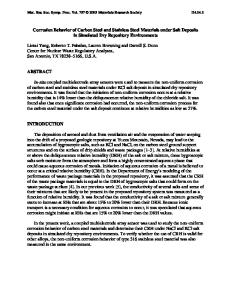Electrochemical Behavior of Steel in Concrete Under Wet and Dry Condition with NaCl Solution
- PDF / 2,290,352 Bytes
- 9 Pages / 593.972 x 792 pts Page_size
- 83 Downloads / 352 Views
JMEPEG https://doi.org/10.1007/s11665-019-03909-3
Electrochemical Behavior of Steel in Concrete Under Wet and Dry Condition with NaCl Solution Toshiyasu Nishimura (Submitted July 11, 2018; in revised form December 25, 2018) The corrosion of steel and environmental factors in concrete under the wet and dry condition were examined by using electrochemical impedance spectroscopy (EIS) and microelectrode sensors. The concentration of chloride ion (CL) was detected by Ag/AgCl microelectrode, and the pH was monitored by W/ WOx one. The CL increased step by step according to the wet and dry condition. Besides, the cathodic current of the oxygen (IO2 ) was increased just after the immersion of concrete sample in wet process. These behaviors were thought to promote the corrosion of steel. From EIS, the rust was formed and destroyed on the surface of steel in concrete under the wet and dry condition. It was quantitatively demonstrated by monitoring that the corrosion of steel started when CL exceeded the threshold value in concrete under the wet and dry condition. Keywords
chloride, concrete, corrosion, EIS, monitoring, pH, steel
1. Introduction Deterioration of concrete structures has become a serious problem in recent years. Besides, in many cases, this deterioration is caused by corrosion of the reinforcing steel under a severe environment. Thus, the relation between cracks of concrete and corrosion product (rust) was deeply examined by Zhao (Ref 1), Du (Ref 2), Zhan (Ref 3) and Chen (Ref 4), et al. Besides, the long-term measuring on the corrosion of steels was conducted by Xiong (Ref 5) and Fu (Ref 6), et al. On the other hand, stainless steels have been applied to reinforcing steels to improve the corrosion resistance. Luo et al. (Ref 7) showed the high corrosion resistance of 316L and duplex stainless steels (Ref 8) in chlorinated simulated concrete pore solution. Feng et al. (Ref 9) examined the pitting of 304 stainless steel in chloride contaminated concrete pore solution. Therefore, the relation between the crack and the rust is well examined for a long time, and the stainless steels are proposed to reinforcing steel recently. However, it is not well understood about the relation between the corrosion of steel in concrete and environmental factors at beginning stage of atmospheric condition. This environmental condition is identified as the wet and dry cycle with a NaCl solution in the laboratory experiment. However, as the corrosion behavior of steel in concrete under this condition is complicated, the mechanism is not still understood clearly. On the other hand, as concrete structures are different from each other, it is important to monitor the environmental factors and the corrosion of steel for individual cases. Recently, there
Toshiyasu Nishimura, National Institute for Materials Science (NIMS), 1-2-1 Sengen, Tsukuba 305-0047, Japan. Contact e-mail: [email protected].
Journal of Materials Engineering and Performance
have been attempts to measure the concentration of chloride ions using variou
Data Loading...











